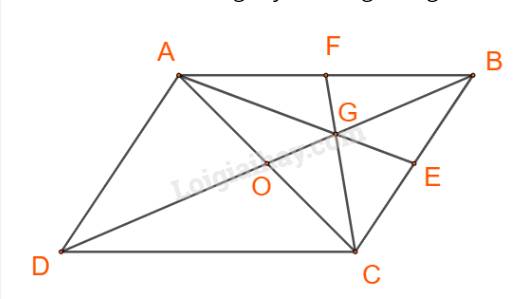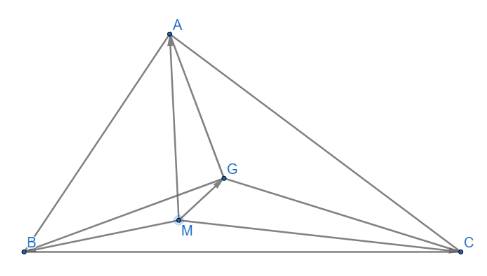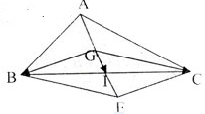Cho tam giác ABC trọng tâm G, đặt \(\overrightarrow{GA}=\overrightarrow{a};\overrightarrow{GB}=\overrightarrow{b}\), biểu diễn \(\overrightarrow{GC}=m\overrightarrow{a}+m\overrightarrow{b}\). Tổng m + n =...

Những câu hỏi liên quan
Cho tam giác đều ABC có cạnh bằng a, gọi G là trọng tâm. Tính T: \(\overrightarrow{GA}.\overrightarrow{BC}+\overrightarrow{GB}.\overrightarrow{CA}+\overrightarrow{GC}.\overrightarrow{AB}\)
\(T=\overrightarrow{GA}\left(\overrightarrow{BA}+\overrightarrow{AC}\right)+\overrightarrow{GB}.\overrightarrow{CA}+\overrightarrow{GC}.\overrightarrow{AB}\)
\(=\overrightarrow{AB}\left(\overrightarrow{GC}-\overrightarrow{GA}\right)+\overrightarrow{AC}\left(\overrightarrow{GA}-\overrightarrow{GB}\right)\)
\(=\overrightarrow{AB}\left(\overrightarrow{GC}+\overrightarrow{AG}\right)+\overrightarrow{AC}\left(\overrightarrow{GA}+\overrightarrow{BG}\right)\)
\(=\overrightarrow{AB}.\overrightarrow{AC}+\overrightarrow{AC}.\overrightarrow{BA}\)
\(=0\)
Đúng 1
Bình luận (0)
Cho tam giác ABC. Chứng minh rằng nếu \(\overrightarrow{GA}+\overrightarrow{GB}+\overrightarrow{GC}=\overrightarrow{0}\) thì G là trọng tâm của tam giác ABC ?
Ta đã biết nếu G' là trọng tâm tam giác ABC thì:
\(\overrightarrow{G'A}+\overrightarrow{G'B}+\overrightarrow{G'C}=\overrightarrow{0}\).
Gỉa sử có điểm G thỏa mãn: \(\overrightarrow{GA}+\overrightarrow{GB}+\overrightarrow{GC}=\overrightarrow{0}\).
Ta sẽ chứng minh \(G\equiv G'\).
Thật vậy:
\(\overrightarrow{GA}+\overrightarrow{GB}+\overrightarrow{GC}=\overrightarrow{0}\)
\(\Leftrightarrow3\overrightarrow{GG'}+\overrightarrow{G'A}+\overrightarrow{G'B}+\overrightarrow{G'C}=\overrightarrow{0}\)
\(\Leftrightarrow3\overrightarrow{GG'}=\overrightarrow{0}\)
\(\Leftrightarrow\overrightarrow{GG'}=\overrightarrow{0}\).
Vậy \(G\equiv G'\).
Đúng 0
Bình luận (0)
Cho tam giác ABC , G là trọng tâm . Chứng minh rằng \(\overrightarrow{GA}+\overrightarrow{GB}+\overrightarrow{GC}=0\)
Kéo dài đoạn BM , lấy thuộc BM sao cho MC' = MG
=> ADCG là hình bình hành
=> GB = 2GM = GC'
Ta có : \(\overrightarrow{GA}+\overrightarrow{GB}=\overrightarrow{GC'}=\overrightarrow{CG}\) (quy tắc hình bình hành)
\(\Rightarrow\overrightarrow{GA}+\overrightarrow{GB}+\overrightarrow{GC}=\overrightarrow{CG}+\overrightarrow{GC}=\overrightarrow{CC}=\overrightarrow{0}\)
Đúng 0
Bình luận (0)
Gọi G \(\in\) trung tuyến AE, D đối xứng với E qua G
=> BGCD là hình bình hành
=> \(\overrightarrow{GB}\) + \(\overrightarrow{GC}\) = \(\overrightarrow{GD}\) ( quy tắc HBH) và \(\overrightarrow{GA}\) +\(\overrightarrow{GD}\) = 0
Ta có:
\(\overrightarrow{GA}\) + \(\overrightarrow{GB}\) + \(\overrightarrow{GC}\) = \(\overrightarrow{GA}\) +\(\overrightarrow{GD}\) = \(\overrightarrow{0}\) (đpcm)
Đúng 0
Bình luận (0)
cho tam giác ABC có trọng tâm là G và M là trung điểm BC. Khẳng định nào sau đây là saiA. overrightarrow{AG}dfrac{2}{3}overrightarrow{AM} B. overrightarrow{AB}+overrightarrow{AC}3overrightarrow{AG} C. overrightarrow{GA}overrightarrow{BG}+overrightarrow{GC} D.overrightarrow{GB}+overrightarrow{GC}overrightarrow{GM}giúp mk giải câu C , D thôi cx đc tại cô mk bảo phải cm từng câu cho nên m.n giúp mk vs
Đọc tiếp
cho tam giác ABC có trọng tâm là G và M là trung điểm BC. Khẳng định nào sau đây là sai
A. \(\overrightarrow{AG}=\dfrac{2}{3}\overrightarrow{AM}\)
B. \(\overrightarrow{AB}+\overrightarrow{AC}=3\overrightarrow{AG}\)
C. \(\overrightarrow{GA}=\overrightarrow{BG}+\overrightarrow{GC}\)
D.\(\overrightarrow{GB}+\overrightarrow{GC}=\overrightarrow{GM}\)
giúp mk giải câu C , D thôi cx đc tại cô mk bảo phải cm từng câu cho nên m.n giúp mk vs
c) \(\overrightarrow{BG}+\overrightarrow{GC}=\overrightarrow{BC}\ne\overrightarrow{GA}\)
d) \(\overrightarrow{GB}+\overrightarrow{GC}=\dfrac{1}{2}\overrightarrow{GM}\ne\overrightarrow{GM}\)
Đúng 0
Bình luận (0)
Cho ABCD là hình bình hành. Đặt \(\overrightarrow {AB} = \overrightarrow a ,\overrightarrow {AD} = \overrightarrow b .\) Gọi G là trọng tâm của tam giác ABC. Biểu thị các vecto \(\overrightarrow {AG} ,\overrightarrow {CG} \) theo hai vecto \(\overrightarrow a ,\overrightarrow b .\)
Cách 1:
Gọi O là giao điểm của AC và BD.

Ta có:
\(\begin{array}{l}\overrightarrow {AG} = \overrightarrow {AB} + \overrightarrow {BG} = \overrightarrow a + \overrightarrow {BG} ;\\\overrightarrow {CG} = \overrightarrow {CB} + \overrightarrow {BG} = \overrightarrow {DA} + \overrightarrow {BG} = - \overrightarrow b + \overrightarrow {BG} ;\end{array}\)(*)
Lại có: \(\overrightarrow {BD} =\overrightarrow {BA} + \overrightarrow {AD} = - \overrightarrow a + \overrightarrow b \).
\(\overrightarrow {BG} ,\overrightarrow {BD} \) cùng phương và \(\left| {\overrightarrow {BG} } \right| = \frac{2}{3}BO = \frac{1}{3}\left| {\overrightarrow {BD} } \right|\)
\( \Rightarrow \overrightarrow {BG} = \frac{1}{3}\overrightarrow {BD} = \frac{1}{3}\left( { - \overrightarrow a + \overrightarrow b } \right)\)
Do đó (*) \( \Leftrightarrow \left\{ \begin{array}{l}\overrightarrow {AG} = \overrightarrow a + \overrightarrow {BG} = \overrightarrow a + \frac{1}{3}\left( { - \overrightarrow a + \overrightarrow b } \right) = \frac{2}{3}\overrightarrow a + \frac{1}{3}\overrightarrow b ;\\\overrightarrow {CG} = -\overrightarrow b + \overrightarrow {BG} = -\overrightarrow b + \frac{1}{3}\left( { - \overrightarrow a + \overrightarrow b } \right) = - \frac{1}{3}\overrightarrow a - \frac{2}{3}\overrightarrow b ;\end{array} \right.\)
Vậy \(\overrightarrow {AG} = \frac{2}{3}\overrightarrow a + \frac{1}{3}\overrightarrow b ;\;\overrightarrow {CG} = - \frac{1}{3}\overrightarrow a - \frac{2}{3}\overrightarrow b .\)
Đúng 1
Bình luận (0)
Cách 2:
Gọi AE, CF là các trung tuyến trong tam giác ABC.

Ta có:
\(\overrightarrow {AG} = \frac{2}{3}\overrightarrow {AE} = \frac{2}{3}.\frac{1}{2}\left( {\overrightarrow {AB} + \overrightarrow {AC} } \right) = \frac{2}{3}.\frac{1}{2}\left[ {\overrightarrow {AB} + \left( {\overrightarrow {AB} + \overrightarrow {AD} } \right)} \right] \\= \frac{1}{3}\left( {2\overrightarrow a + \overrightarrow b } \right) = \frac{2}{3}\overrightarrow a + \frac{1}{3}\overrightarrow b \)
\(\overrightarrow {CG} = \frac{2}{3}\overrightarrow {CF} = \frac{2}{3}.\frac{1}{2}\left( {\overrightarrow {CA} + \overrightarrow {CB} } \right) = \frac{2}{3}.\frac{1}{2}\left[ {\left( {\overrightarrow {CB} + \overrightarrow {CD} } \right) + \overrightarrow {CB} } \right] = \frac{1}{3}\left( {2\overrightarrow {CB} + \overrightarrow {CD} } \right) = \frac{1}{3}\left( { - 2\overrightarrow {AD} - \overrightarrow {AB} } \right) = - \frac{1}{3}\overrightarrow a - \frac{2}{3}\overrightarrow b \)
Vậy \(\overrightarrow {AG} = \frac{2}{3}\overrightarrow a + \frac{1}{3}\overrightarrow b ;\;\overrightarrow {CG} = - \frac{1}{3}\overrightarrow a - \frac{2}{3}\overrightarrow b .\)
Đúng 0
Bình luận (0)
Cho tứ diện ABCD. Gọi G là trọng tâm của tam giác ABC. Chứng minh rằng :
\(\overrightarrow{GD.}\overrightarrow{GA}+\overrightarrow{GD}.\overrightarrow{GB}+\overrightarrow{GD}.\overrightarrow{GC}=0\)
Cho tam giác ABC. Chứng minh G là trọng tâm của tam giác ABC khi và chỉ khi \(\overrightarrow {MA} + \overrightarrow {MB} + \overrightarrow {MC} = 3\overrightarrow {MG} \)

\(\overrightarrow {MA} + \overrightarrow {MB} + \overrightarrow {MC} = 3\overrightarrow {MG} \Leftrightarrow \overrightarrow {MG} + \overrightarrow {GA} + \overrightarrow {MG} + \overrightarrow {GB} + \overrightarrow {MG} + \overrightarrow {GC} = 3\overrightarrow {MG} \)
\( \Leftrightarrow \left( {\overrightarrow {MG} + \overrightarrow {MG} + \overrightarrow {MG} } \right) + \left( {\overrightarrow {GA} + \overrightarrow {GB} + \overrightarrow {GC} } \right) = 3\overrightarrow {MG} \)
\( \Leftrightarrow 3\overrightarrow {MG} = 3\overrightarrow {MG} \) (đpcm) ( Vì G là trọng tâm của tam giác ABC nên \(\overrightarrow {GA} + \overrightarrow {GB} + \overrightarrow {GC} = \overrightarrow 0 \))
Đúng 0
Bình luận (0)
Cho tam giác ABC có trọng tâm G, đặt \(\overrightarrow{a}=\overrightarrow{GA},\overrightarrow{b}=\overrightarrow{GB}\). Khi đó \(\frac{1}{2}\overrightarrow{AB}-\overrightarrow{BC}=...\)
Lời giải:
$G$ là trọng tâm tam giác $ABC$ thì ta có 1 bổ đề quen thuộc là:
$\overrightarrow{GA}+\overrightarrow{GB}+\overrightarrow{GC}=\overrightarrow{0}$
$\Leftrightarrow \overrightarrow{a}+\overrightarrow{b}+\overrightarrow{GC}=\overrightarrow{0}$
$\Rightarrow \overrightarrow{GC}=-(\overrightarrow{a}+\overrightarrow{b})$
Ta có:
\(\frac{1}{2}\overrightarrow{AB}-\overrightarrow{BC}=\frac{1}{2}(\overrightarrow{AG}+\overrightarrow{GB})-(\overrightarrow{BG}+\overrightarrow{GC})\)
\(=\frac{1}{2}(-\overrightarrow{a}+\overrightarrow{b})-[-\overrightarrow{b}-(\overrightarrow{a}+\overrightarrow{b})]\)
\(=\frac{\overrightarrow{a}}{2}+\frac{5\overrightarrow{b}}{2}\)
Đúng 0
Bình luận (0)
Cho tam giác ABC có G là trọng tâm. I là trung điểm của đoạn thẳng BC. Đẳng thức nào sau đúng ?
a) overrightarrow{GA}2overrightarrow{GI}
b) overrightarrow{IG}-dfrac{1}{3}overrightarrow{IA}
c) overrightarrow{GB}+overrightarrow{GC}2overrightarrow{GI}
d) overrightarrow{GB}+overrightarrow{GC}overrightarrow{GA}
Đọc tiếp
Cho tam giác ABC có G là trọng tâm. I là trung điểm của đoạn thẳng BC. Đẳng thức nào sau đúng ?
a) \(\overrightarrow{GA}=2\overrightarrow{GI}\)
b) \(\overrightarrow{IG}=-\dfrac{1}{3}\overrightarrow{IA}\)
c) \(\overrightarrow{GB}+\overrightarrow{GC}=2\overrightarrow{GI}\)
d) \(\overrightarrow{GB}+\overrightarrow{GC}=\overrightarrow{GA}\)





















